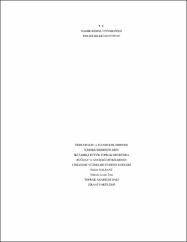| dc.contributor.author | Nalbant, Hafize | |
| dc.date.accessioned | 2017-04-21T06:59:33Z | |
| dc.date.available | 2017-04-21T06:59:33Z | |
| dc.date.issued | 2007 | |
| dc.identifier.uri | https://hdl.handle.net/20.500.11776/294 | |
| dc.description.abstract | Bu deneme, Tekirdag il sınırları içinde yogunluk arz eden Alüviyal ve Kahverengi Orman topraklarında agılıklı olarak tarımı yapılan bugday (Flamura 85, Pehlivan) ve ayçiçegi (Sanay, Pioner 42-23) bitkilerin yetistirilmesi esnasında yabancı otlarla mücadelede bölgesel olarak kullanılan trifluralin ve flurochloridone etki maddesi içeren herbisitlerin çimlenme üzerine etkililerinin arastırılması amacıyla laboratuar kosullarında gerçeklestirilmistir. Uygulama her iki herbisit çesidi için de 4 farklı dozda yapılmıstır. Uygulama dozları trifluralin için; 0, 200, 250, 375 ml/da ve flurochloridone için; 0, 300, 375, 562 ml/da üzerinden olarak uygulanmıstır. Her bir doz için ayçiçegi ve bugday tohumları iki farklı derinlige ekilerek, derinlik ile ilaç çesitlerinin çimlenme üzerine etkileri arastırılmıstır. Ayçiçegi için ekim derinlikleri; 4 ve 7 cm, bugday için ise bu derinlikler; 2 ve 5 cm olarak uygulanmıstır. Tesadüf blokları deneme desenine göre laboratuar kosullarında 2x2x2x2x2x4 düzeyindeki denekler 3 tekerrürlü olarak kullanılmıstır. Elde edilen sonuçlar ısıgında, ayçiçegi tohumu için toprak tipi ile kullanılan ilaç dozlarının flurochloridone etkili hebisitin çıkıs yüzdesine engelleyici etkisinin oldugu bulunmustur. Söyle ki; Alivüyal toprakta 0 doz için çıkıs yüzdesi 99.67 ile en yüksek degerdeyken, 375 ml/da ilaç dozu uygulamasında çıkıs yüzdesi 82.67 ile en düsük degerdedir. Kahverengi Orman topragında ise, 0 dozda çıkıs yüzdesi 91.33 ile en yüksek degerdeyken 300 ml/da ilaç dozu uygulamasında çıkıs yüzdesi 62.33 ile en düsük degeri vermektedir. Trifluralin etki maddeli herbisitte toprak tipi ve ilaç dozunun birlikte ayçiçegi tohumu çıkıs yüzdelerini engelleyici etkisi oldugu bulunmustur. Söyle ki; 0 dozda Alüviyal toprakta çıkıs yüzdesi 99.33 ile en yüksek degerdeyken 375 ml/da ilaç dozunda 88.00 ile en düsük degerdedir. Kahverengi Orman topragında 0 dozda çıkıs yüzdesi 99.67 en yüksek degerdeyken 250 ml/da ilaç dozunda ise 88.00 ile en düsük degerdedir. Yine elde edilen sonuçlar dogrultusunda bugday tohumu için flurochloridone ve trifluralin etki maddeli herbisitlerde toprak tipi ile ilaç dozlarının birlikte etkileriyle toprak tipinin çıkıs yüzdesini engelleyici etkisi olmadıgı bulunmustur. | en_US |
| dc.description.abstract | This experiment has been executed for the purpose investigating the effects of herbicides including effective substance of trifluralin and fluorchloridone, on sprouting under the lab conditions, that are used regionally in fighting weeds during plant breeding of wheat, (Flamura 85, Pehlivan) and sunflower (Sanay, Pioner 42-23) that are mainly bred in Alluvial and Brown Forest soils that have intensity within the province border of Tekirdag. Application has been performed on both herbicide types in 4 different doses. Application doses has been applied over 0, 200, 250, 375 ml/da for trifluralin and over 0, 300, 375, 562 ml/da for flurochloridone. Per each dose, sunflower and wheat seeds he been planted in two different depths, and effects of depth and medicine types on sprouting has been researched. Planting depths has been applied 4 and 7 cm for sunflower, and 2 and 5 cm for wheat. Subjects have been used with 3 repetitions in lab conditions in 2x2x2x2x2x4 level according to accidental blocks experimental pattern. Under the light of obtained results, it has been found out that soil type for sunflower seed and the dose of medicines used has been preventive to the output percentage of flurochloridone effected herbicide. In other words; while the output percentage in Alluvial soils for 0 dose was highest with 99.67, output percentage in medicine dose application in 375 ml/da was lowest with 82.67. And while the output percentage in Brown Forest soil for 0 dose was highest with 91.33, in medicine dose application in 300 ml/da output percentage gives the lowest value with 62.33. It has been found out that soil type and medicine dose in herbicide with trifluralin effected substance together had preventive effect on sunflower seed output percentages. In other words, while the output percentage in Alluvial soils for 0 dose was highest with 99.33, output percentage in medicine dose application in 375 ml/da was lowest with 88.00. And while the output percentage in Brown Forest soil for 0 dose was highest with 99.67, output percentage in medicine dose application in 250 ml/da was lowest with 88.00. Also, in the direction of the results obtained, It has been found out that soil type and medicine dose in herbicide with fluorochloridone and trifluralin effected substance together had no preventive effect for wheat seed output percentages. | en_US |
| dc.language.iso | tur | en_US |
| dc.publisher | Namık Kemal Üniversitesi | en_US |
| dc.rights | info:eu-repo/semantics/openAccess | en_US |
| dc.subject | Flurochloridone | en_US |
| dc.subject | trifluralin | en_US |
| dc.subject | bugday | en_US |
| dc.subject | ayçiçegi | en_US |
| dc.subject | wheat | en_US |
| dc.subject | sunflower | en_US |
| dc.title | Trifluralin ve fluorochloridone içerikli herbisitlerin iki farklı büyük toprak grubunda buğday ve ayçiçeği bitkilerinin çimlenme yüzdeleri üzerine etkileri | en_US |
| dc.title.alternative | The effects of herbisits which cointains trifluralin and fluorochloridone on germinating percentage of wheat and sunflower in two giant soil group | en_US |
| dc.type | masterThesis | en_US |
| dc.department | Enstitüler, Fen Bilimleri Enstitüsü, Toprak Bilimi ve Bitki Besleme Ana Bilim Dalı | en_US |
| dc.relation.publicationcategory | Tez | en_US |



















